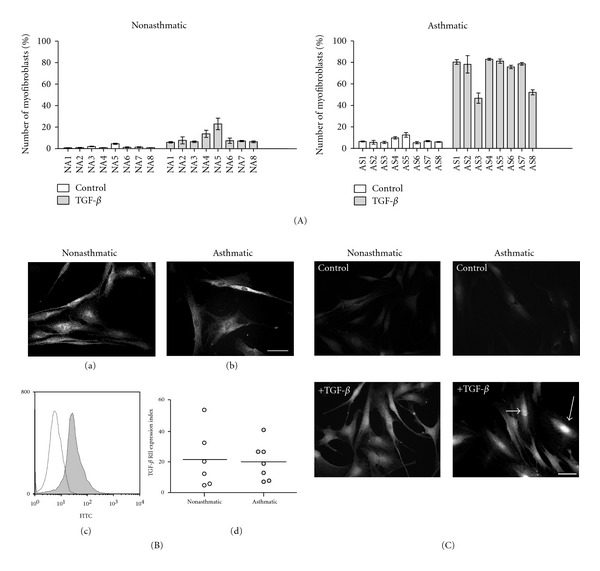Figure 1.

Phenotypic shifts in nonasthmatic and asthmatic HBF populations induced by TGF-β 1. Administration of TGF-β 1 resulted in a prominent FMT in AS HBF populations, illustrated by relatively high fractions of α-SMA-positive cells (A). This effect is independent of TGF-β RII levels (B) but correlates with nuclear accumulation of p-Smad2 (C). (A) HBFs from NA (n = 8) and AS (n = 8) were cultured in DMEM with 10% FCS for 24 hours, and then in serum-free conditions with or without 5 ng/mL TGF-β 1 for 7 days, and fractions of α-SMA-positive cells were detected. Each column represents the percentage of myofibroblasts for each individual HBF culture (±SE). In the AS group, the percentage of positive cells was significantly higher than in the NA group in TGF-β 1-treated cultures (Kruskal-Wallis nonparametric ANOVA, *P < 0.05). (B) For the estimation of TGF-β RII levels, NA and AS HBFs were cultured in DMEM with 10% FCS for 24 hours, immunostained for TGF-β RII, and analyzed by both fluorescence microscopy and FACS. Representative fluorescence microscopy images (bar = 50 μm) illustrate a similar pattern of expression of TGF-β RII in HBF from NA (a) and AS (b) cultures. Representative histogram showing the specificity of TGF-β RII staining in comparison with isotype control (c). TGF-β RII expression levels were similar in both studied groups. Each point of the graph (d) represents data obtained from a single cell population (NA or AS) and horizontal bars represent the mean values. (C) TGF-β 1-induced p-Smad2 translocation to the nucleus in HBFs. Fibroblasts from NA and AS were cultured in serum-free conditions for 24 hours and then with (+TGF-β) or without (control) TGF-β 1 (5 ng/mL), next cells were immunostained for p-Smad2 and photographed with fluorescence microscopy. After 30 minutes of treatment with TGF-β 1, nuclear accumulation of p-Smad2 was detectable, and was more pronounced in AS HBFs (arrows). Bar = 50 μm.
